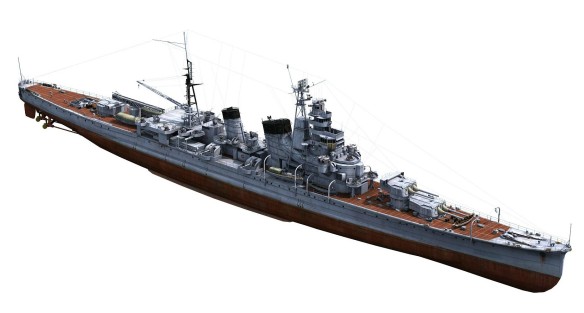
Aoba 1927:
Both ships looked like that once completed, a catapult was envisaged but not yet available at the time of completion.
Aoba 1945:
By the time of her sinking a Type 22 surface search radar had been added, also the AA-suite was further upgraded when the cruiser was relegated to a mere anti aircraft platform in Kure harbor because of irreparable battle damage suffered between late 1944 and early 1945.
Five classes of heavy cruiser were completed by the Japanese before 1939. Each class had something different to offer. Furutaka (with a flush deck), Aoba (the first to use a catapult), Myoko (a triple hull and an arched bulkhead to improve underwater protection), Takao (greater bridge protection) and Tone (five aircraft). Of the light cruisers, the four ships of the Sendai class, by concentrating on engine development and boiler configurement, could reach speeds of 35.2 knots, more than 2 knots faster than anything the Americans could produce during the interwar period. Only one Yubari was ever completed, but she could reach 35.5 knots. Nonetheless, she is best remembered for her side armour which was fitted internally and at a slightly inclined angle. It was an experiment that would be repeated in the later classes of heavy cruiser. Of all the light cruisers, however, the four ships of the Mogami class inspired envy if not fear in the hearts of the British. Their engines could develop a thrust of 152,000 shaft horse power and a speed of 37 knots. This made them about 4.5 knots faster than the Leander class that had been completed only 2–4 years before them.
#
Aoba, first of a class of two 8300-ton heavy cruisers, was built at Nagasaki , Japan. Her sister ship was the Kinugasa. Commissioned in September 1927, she was assigned to Fifth Squadron (Sentai) until 1933 and thereafter to the Sixth and Seventh Squadrons, serving as their flagship during much of her career. In addition to participation in the Japanese Navy’s operational exercises, she frequently served in Chinese waters in the late 1920s and the 1930s during that nation’s ordeals with domestic violence and foreign intervention.
The cruiser was modernized at Sasebo between 1938 and 1940, receiving new torpedo tubes, an enhanced anti-aircraft gun battery, improved gunfire controls and better aircraft handling facilities. Her bridge structure was rebuilt and bulges added to her hull to compensate for the associated weight increases and improve her stability. After recommissioning in October 1940, Aoba served with the Sixth Squadron during its pre-World War II operations in Japanese, Chinese and central Pacific waters. Soon after war began in December 1941, she took part in the capture of Guam and Wake. In May 1942 she participated in the Battle of the Coral Sea .
During the Guadalcanal campaign that began in August 1942, Aoba was heavily engaged with Allied sea and air forces, participating in the the 9 August Battle of Savo Island and the Battle of Cape Esperance on 13 October. She was seriously damaged by U.S. warship gunfire in the latter action, which took the lives of nearly eighty of those on board, including the Sixth Squadron’s commander, Rear Admiral Aritomo Goto.
After repairs, Aoba returned to the south Pacific war zone in February 1943, only to be hit by air attack on 3 April. The badly damaged ship was out of action until December 1943, when she was assigned to the East Indies area. Kept busy for the next ten months carrying supplies and maintaining readiness for offensive operations, she was en route to participate in the Battle of Leyte Gulf on 23 October 1944 when the U.S. submarine Bream (SS-243) hit her amidships with a torpedo. Though further damaged by bombs in October, Aoba was able to reach Japan in mid-December.
Aoba remained at or near Kure , Japan for the rest of the Pacific War, being used only as a floating anti-aircraft battery. In attacks by U.S. carrier planes and Air Force bombers on 24 and 28 July 1945 , she was hit several times and sunk in shallow water. Her wreck was scrapped in 1946-47.
Kinugasa, an 8300-ton Aoba class heavy cruiser built at Kobe, Japan, was commissioned in September 1927. Her early service was as flagship of the Fifth Squadron (Sentai), and she operated for virtually her entire career with that unit and the Sixth and Seventh Squadrons. In 1928, she became the first Japanese combat ship to carry an aircraft catapult. Kinugasa served off China in 1928 and 1929 and on several occasions during the 1930s. Placed in reserve in September 1937, she was extensively modernized and did not recommission until the end of October 1940.
Kinugasa was assigned to the Sixth Squadron during the year leading up to the start of the Pacific War. In December 1941, the war’s first month, she took part in the seizure of the American outposts at Guam and Wake. She participated in the Battle of the Coral Sea in May 1942 and in the heavy fighting to retake Guadalcanal later in the year. During the latter campaign, she took part in the Battle of Savo Island on 9 August, the Battle of Cape Esperance on 13 October and in the shelling of Guadalcanal’s Henderson Field on 14 November 1942. While withdrawing on the morning after that bombardment, Kinugasa was sunk by planes based at Henderson Field and on the aircraft carrier Enterprise (CV-6).